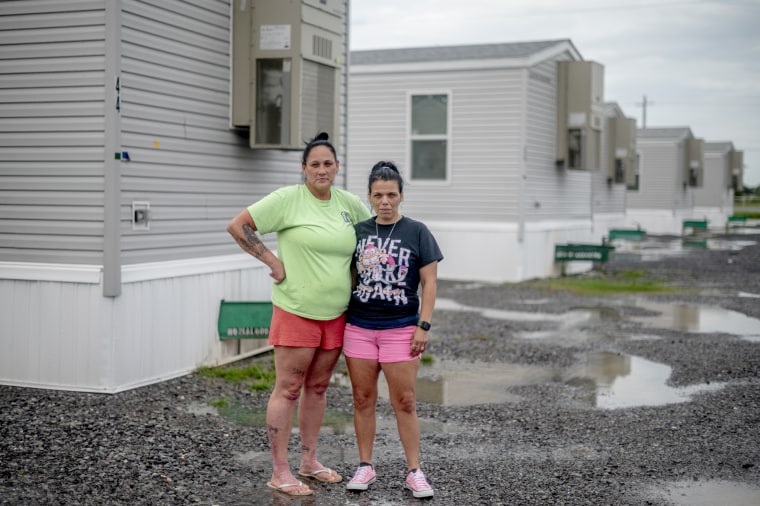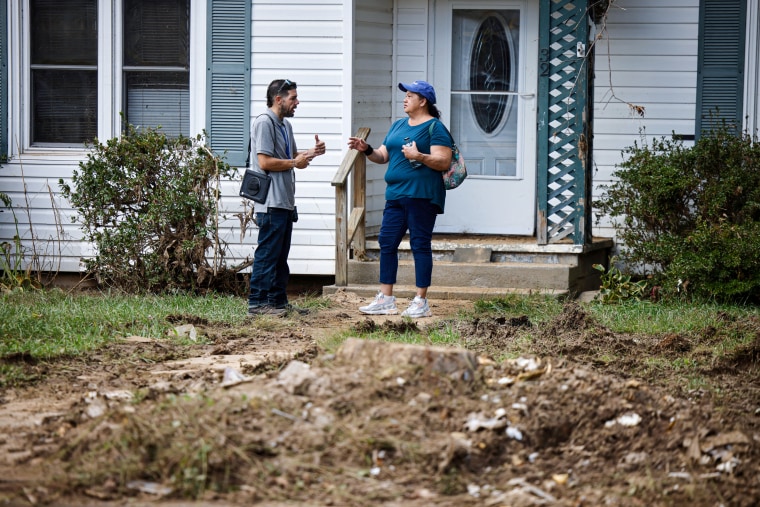FEMA conspiracy theories that have stoked chaos in the South date back to the 1980s
In the wake of hurricanes Helene and Milton, an outlandish conspiracy theory about the Federal Emergency Management Agency that has percolated for decades started to reappear online. Now, the government agency is making one of its strongest pushes against the claim to date.
In a new section of its hurricane rumor response page published Wednesday, FEMA looked to put to rest the long-lasting conspiracy theory that’s followed it since shortly after the agency was founded. Known as the “FEMA camps” theory, it falsely speculates that the agency sets up camps meant to “detain people.”
On the page, the government agency wrote that it has recently set up temporary housing for staff responding to the aftermath of Hurricane Helene in a few locations in western North Carolina. FEMA added that there are over a thousand FEMA staff in the state and that the lodging, which is protected by security personnel, is for staff and “not for any other purpose.” It called the “FEMA camp” rumors “all false.”
“‘FEMA camp’ rumors are founded in long-standing conspiracy theories intended to discredit our efforts to help survivors,” the page reads. “FEMA does not round up or detain people, does not enact martial law, does not set up internment camps, and does not secretly operate mining settlements.”
A FEMA spokesperson said the government agency addressed the rumor to “set the record straight” after “noticing a sustained volume of false and misleading information that impacted survivors and response efforts” about its responder lodging, which FEMA sets up by consulting with state and local officials.
In the past, FEMA has also set up temporary housing units for survivors, usually around 30 to 50 units in one area, depending on need. The spokesperson added that there are currently no temporary housing units for survivors in North Carolina.

In the past month, videos and photos of FEMA worker sites in the South were posted online, drawing hundreds of thousands of views and commentary speculating that they were actually “FEMA camps.”
“I imagine this could be where they take people who refuse to leave their properties,” one X user speculated last week.
The “FEMA camps” conspiracy theory is the belief that FEMA is a cover for what could become a “widespread domestic internment camp system to hold citizens deemed to be problematic or extremists,” Sara Aniano, a disinformation analyst at the Anti-Defamation League’s Center on Extremism, told NBC News.
To most, the false conspiracy theory may seem far-fetched, but skepticism around FEMA’s intentions has stoked chaos in regions affected by the hurricanes, with one man arrested for allegedly threatening employees of the agency, and FEMA making adjustments to its workflows over safety concerns. The man was later released after paying a $10,000 secured bond.
An agency spokesperson said that for every natural disaster, FEMA has set up a rumor response page to address misinformation, including for Covid-19. When the agency begins to see a trend of misinformation circulating online, the spokesperson added, the agency will create a rumor response page. In recent years, the government agency has set up various rumor response pages about the winter storms in Texas, wildfires in New Mexico and Hawaii, and one for Hurricane Fiona.
When wildfires broke out in Maui last year, USA Today reported on the spread of the FEMA camp conspiracy theory after a Facebook user posted a video showing a series of shelters, captioning it “FEMA camps.” A FEMA spokesperson told USA Today the rumor was “false” and that the government agency did not build any housing in Maui at the time. Unlike with the hurricane rumor response page, FEMA did not appear to respond to the rumors on its page for the wildfires.
The conspiracy theories about FEMA first emerged several years after FEMA’s creation in 1979 by former President Jimmy Carter following a series of natural disasters in the 1960s and ’70s including 1969’s Hurricane Camille, which struck Mississippi and resulted in more than a billion dollars in damage and over 200 deaths. That same year, Carter signed another executive order that gave FEMA “the dual mission of emergency management and civil defense.”
Two years into the federal agency’s founding, a newsletter written by a right-wing, antigovernment movement called Posse Comitatus made one of the first-ever false mentions of FEMA detention camps, warning that “hardcore patriots” would be imprisoned in them, according to research from the Southern Poverty Law Center. The claim was false, but according to the Center for Strategic and International Studies, it exemplified fears of federal overreach that helped propel the emergence of the U.S. militia movement

In 1987, the detention camp conspiracy was propelled further after several news articles documented how Marine Lt. Col. Oliver North of the Reagan administration had drafted a plan to implement martial law in the U.S. in which powers would be handed over to FEMA in the case of an emergency such as nuclear war.
Rebecca Rouse, a professor who teaches practice, emergency and security studies at Tulane University and previously worked at FEMA from 2019 to 2020, told NBC News that real events often help seed the beginnings of false conspiracy theories. She said she thinks the existence of detention camps throughout history, including U.S. camps that imprisoned people of Japanese descent during World War II and the current migrant camps at the U.S.-Mexico border, have fueled the conspiracy theories.
“The knowledge that there’s versions of things that happen, I think, makes us more likely to believe something truly awful could happen,” Rouse said.
Conspiracism became intertwined with violence with the 1995 Oklahoma City bombing, whose perpetrators aligned themselves with the right-wing, antigovernment “Patriot” movement. During Senate hearings following the domestic terrorist attack, members of the movement said they feared that “‘urban gangs,’directed by Washington and possibly acting in concert with U.N. and foreign troops, would sweep in from the coasts, confiscate their guns, and round them up,” and would “send the members of Patriot militias to internment camps run by the Federal Emergency Management Agency,” the Southern Poverty Law Center wrote.
By 2009, Alex Jones, perhaps one of the most widely known modern conspiracy theorists, was promoting the false FEMA camps conspiracy theory and deriding those who attempted to debunk it.
The theory surged again in 2015 following Superstorm Sandy, after the U.S. Army announced that it would begin Jade Helm 15 training — a two-month military exercise focused on techniques for combating “unconventional warfare.” As a result, USA Today reported, conspiracists quickly began to spread the theory that dome-shaped roofs that had been paid for by FEMA were connected to Jade Helm and were made to detain insurrectionists. In reality, the dome roofs were for people to shelter from hurricanes, according to The New York Times.
Following 2017’s Las Vegas mass shooting, in which a man opened fire onto a concert crowd and killed 60 people, The Guardian reported that the shooter had allegedly believed in the FEMA camps conspiracy theory. According to the report, the shooter is alleged to have said that FEMA-led evacuation efforts during Hurricane Katrina were a “dry run for law enforcement and military to start kickin’ down doors and … confiscating guns.”
The ADL’s Aniano said that although it is not possible to pinpoint what causes conspiracy theorists to take violent action, violent actors are often attempting to find a way to combat “perceived enemies.”
“Conspiracy theories create these kind of perceived enemies that don’t necessarily exist as enemies, but they are depicted as such in the conspiratorial narrative, and then extremists or violent actors or what have you then prescribe actions to counter these enemies,” Aniano said. “So if the narrative, as it was again in the past month, is that FEMA is bad, FEMA is harming Americans, FEMA is an existential threat and a threat to America, then of course that gives you somebody to pinpoint.”
When Covid-19 hit, mentions of the FEMA camp conspiracy theory came with it. After then-President Donald Trump declared Covid a nationwide emergency in March 2020, FEMA was one of the lead responders to the pandemic. FEMA had that power due to the Stafford Act of 1988, which allows it to become a leading agency when the president declares an emergency in response to a natural disaster. An agreement was later made that would allow FEMA to provide noncongregate shelters for those who would not be able to quarantine in their own homes. However, many began speculating that this was another iteration of the FEMA camps.
In response to an uptick in rumors, Ohio Gov. Mike DeWine hosted a press briefing in September 2020 where he addressed the FEMA camps conspiracy theory, calling it “crazy” and “ridiculous.” He said he was prompted to address the rumor after receiving numerous calls concerning it.
“The bottom line, neither President Trump’s FEMA nor the Ohio Department of Health are going to set up FEMA camps for anyone to quarantine against their will,” DeWine said. “What we are doing is making available a safe place for people to stay when they have loved ones that they’re trying to protect, and they have no other, no other place to go.”
Nevertheless, state Rep. Bill Seitz, a Republican, seemed to give some credence to the rumors, according to Ohio Public Radio, saying that the noncongregate sheltering “order was worded far too broadly” and gave government officials the power to say “‘OK, we don’t think you’re going to quarantine at home like we’re asking you to — off to the internment camp you go.’”
Seitz later said he didn’t think DeWine would use that power, according to the Ohio Public Radio report. Seitz did not immediately respond to a request for comment on his current views regarding the theory and if he had intended to make reference to it.
The FEMA camps conspiracy theory continued throughout the height of the pandemic after President Joe Biden signed various executive orders regarding vaccinations and testing. In one executive order, Biden established that FEMA would be creating up to 100 new vaccination centers. In response to this, Florida Gov. Ron DeSantis said the plan was “not necessary” and referred to the vaccination sites as “FEMA camps.”
Although the FEMA camp conspiracy theory has been shot down again and again, Aniano believes this won’t be the last of it.
“The conspiracy theory, it’s going to come up again,” Aniano said. “Something’s going to happen, some natural disaster, some act of God, and this is going to happen again. I would just warn people to be primed to look out for it.”


